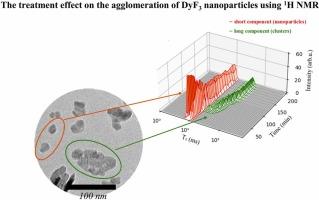用1H NMR研究了处理对DyF3纳米颗粒团聚的影响
IF 6.3
2区 材料科学
Q2 CHEMISTRY, PHYSICAL
引用次数: 0
摘要
通过zeta电位和1H NMR时域测量,研究了不同处理方式下DyF3纳米颗粒的团聚过程。在3.65 T磁场下记录了各样品随时间的1H横向核磁化衰减曲线。采用基于正则化拉普拉斯逆变换(RILT)算法的拉普拉斯逆变换对T2分布进行分析。测定了在高压灭菌器中水热处理的DyF3纳米粒子自旋-自旋弛豫速率的浓度依赖性(0.05 -1 mM)。讨论了热处理方法对DyF3纳米颗粒团聚率的影响。结果表明,热压灭菌法处理胶体溶液比微波处理具有优势。此外,对不同处理的DyF3样品进行了纳米颗粒团聚率的理论估计。最后,毒性研究表明,DyF₃纳米颗粒在浓度高达1mm的情况下毒性可以忽略不计。本文章由计算机程序翻译,如有差异,请以英文原文为准。

The treatment effect on the agglomeration of DyF3 nanoparticles using 1H NMR
The agglomeration processes of DyF3 nanoparticles without and with different types of treatment were studied by the zeta-potential and time-domain 1H NMR measurements. 1H transverse nuclear magnetization decay curves were recorded in a 3.65 T magnetic field for all samples over time. T2 distributions were analyzed using the inverse Laplace transform based on regularized inverse Laplace transformation (RILT) algorithm. The concentration dependence (0.05 −1 mM) of the spin-spin relaxation rate was measured for DyF3 nanoparticles treated hydrothermally in an autoclave. The influence of thermal treatment methods on the agglomeration rate of DyF3 nanoparticles has been discussed. The results demonstrate that of autoclave processing of the colloidal solution offers advantages over microwave treatment. Furthermore, theoretical estimates of nanoparticle agglomeration rates were performed for DyF3 samples subjected to different treatments. Finally, toxicity studies revealed that DyF₃ nanoparticles exhibit negligible toxicity at concentrations up to 1 mM.
求助全文
通过发布文献求助,成功后即可免费获取论文全文。
去求助
来源期刊

Journal of Alloys and Compounds
工程技术-材料科学:综合
CiteScore
11.10
自引率
14.50%
发文量
5146
审稿时长
67 days
期刊介绍:
The Journal of Alloys and Compounds is intended to serve as an international medium for the publication of work on solid materials comprising compounds as well as alloys. Its great strength lies in the diversity of discipline which it encompasses, drawing together results from materials science, solid-state chemistry and physics.
 求助内容:
求助内容: 应助结果提醒方式:
应助结果提醒方式:


